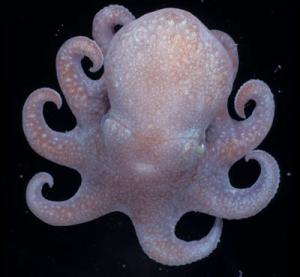
November 10, 2008
Giant oysters, spaceship-like jellyfish and the common ancestor of deep-sea octopuses are just some of the new species discovered by the Census Marine Life, due to be completed in 2010.

Megaleledone setebos is thought to be the common ancestor of the deep-sea octopuses (Image: M. Rauschert)
The Census of Marine Life won’t be complete until 2010, but scientists are already sharing some of their discoveries, including 5,300 new species, an octopus ancestor and a “white shark cafe.”
Some 700 scientists are presenting some of their findings this week in Valencia, Spain, at the World Conference on Marine Biodiversity. The Census of Marine Life project began in 2000; in 2010 the scientists plan to produce a complete list of 230,000 marine species.
The press release for the event and this year’s census update quoted Census vice-chair Myriam Sibuet of France as saying, “The impressive number of landmark findings over the past two years reveals the richness of what remains to be discovered. The vastness of the ocean and our new research tools keep marine biology forever young.”
The new findings include evidence that many deep-sea octopi evolved from an Antarctic octupus species, descendants of which still exist in the Southern Ocean. The photo shows Megaleledone setebos, the closest living relative of the ancient ancestor.
Also, a satellite tagging study revealed that great white sharks congregate in one part of the East Pacific Ocean for six months out of the year. There, both males and females make repeated dives to depths of 300 meters. Scientists speculate that the great whites are either feeding or reproducing in this Pacific “white shark cafe.”
The group will release more new findings every day during the conference, November 11-15.
The ocean is the least-explored place on the planet and the diversity — and weirdness — of its inhabitants always impresses me. What say you?
About Loren Coleman
Loren Coleman is one of the world’s leading cryptozoologists, some say “the” leading living cryptozoologist. Certainly, he is acknowledged as the current living American researcher and writer who has most popularized cryptozoology in the late 20th and early 21st centuries.
Starting his fieldwork and investigations in 1960, after traveling and trekking extensively in pursuit of cryptozoological mysteries, Coleman began writing to share his experiences in 1969. An honorary member of Ivan T. Sanderson’s Society for the Investigation of the Unexplained in the 1970s, Coleman has been bestowed with similar honorary memberships of the North Idaho College Cryptozoology Club in 1983, and in subsequent years, that of the British Columbia Scientific Cryptozoology Club, CryptoSafari International, and other international organizations. He was also a Life Member and Benefactor of the International Society of Cryptozoology (now-defunct).
Loren Coleman’s daily blog, as a member of the Cryptomundo Team, served as an ongoing avenue of communication for the ever-growing body of cryptozoo news from 2005 through 2013. He returned as an infrequent contributor beginning Halloween week of 2015.
Coleman is the founder in 2003, and current director of the International Cryptozoology Museum in Portland, Maine.
Filed under Breaking News, CryptoZoo News, New Species